Glutathione supplementation suppresses muscle fatigue induced by prolonged exercise via improved aerobic metabolism
- PMID: 25685110
- PMCID: PMC4328900
- DOI: 10.1186/s12970-015-0067-x
Glutathione supplementation suppresses muscle fatigue induced by prolonged exercise via improved aerobic metabolism
Abstract
Backgrounds: Glutathione is an endogenous redox couple in animal cells and plays important roles in antioxidant defense and detoxification, although it is unknown if oral glutathione supplementation affects exercise-induced physiological changes. The present study investigated the effect of glutathione intake on exercise-induced muscle metabolism and fatigue in mice and humans.
Methods: ICR mice were divided into 4 groups: sedentary control, sedentary supplemented with glutathione (2.0%, 5 μL/g body weight), exercise control, and exercise supplemented with glutathione. After 2 weeks, the exercise groups ran on a treadmill at 25 m/min for 30 min. Immediately post-exercise, intermuscular pH was measured, and hind limb muscle and blood samples were collected to measure biochemical parameters. In a double-blind, cross-over study, 8 healthy men (35.9 ± 2.0 y) were administered either glutathione (1 g/d) or placebo for 2 weeks. Then, they exercised on a cycle ergometer at 40% maximal heart rate for 60 min. Psychological state and blood biochemical parameters were examined after exercise.
Results: In the mouse experiment, post-exercise plasma non-esterified fatty acids were significantly lower in the exercise supplemented with glutathione group (820 ± 44 mEq/L) compared with the exercise control group (1152 ± 61 mEq/L). Intermuscular pH decreased with exercise (7.17 ± 0.01); however, this reduction was prevented by glutathione supplementation (7.23 ± 0.02). The peroxisome proliferator-activated receptor-γ coactivator-1α protein and mitochondrial DNA levels were significantly higher in the sedentary supplemented with glutathione group compared with the sedentary control group (25% and 53% higher, respectively). In the human study, the elevation of blood lactate was suppressed by glutathione intake (placebo, 3.4 ± 1.1 mM; glutathione, 2.9 ± 0.6 mM). Fatigue-related psychological factors were significantly decreased in the glutathione trial compared with the placebo trial.
Conclusions: These results suggest that glutathione supplementation improved lipid metabolism and acidification in skeletal muscles during exercise, leading to less muscle fatigue.
Keywords: Dkeletal muscle; Glutathione; Lipid metabolism; PGC-1α; Running exercise.
Figures
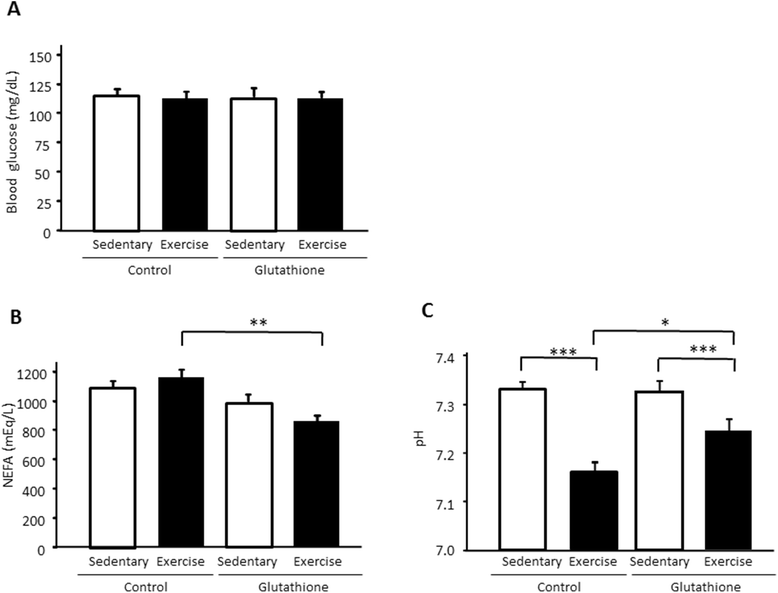
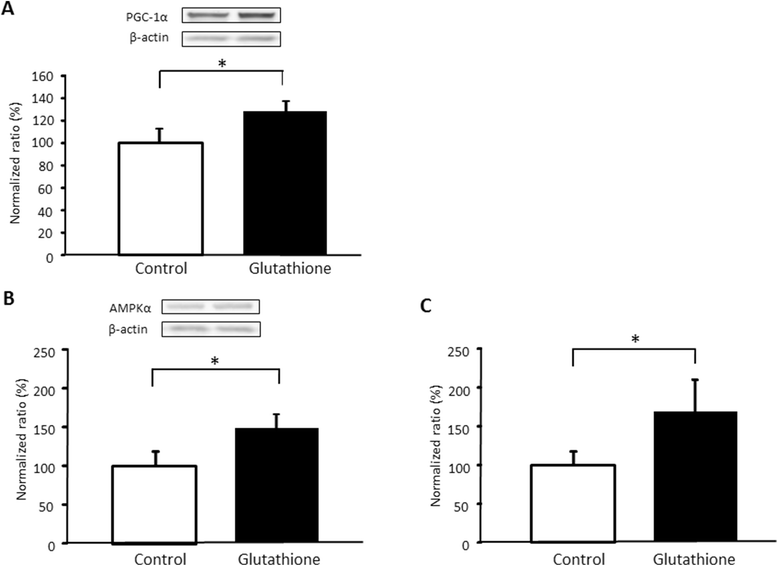
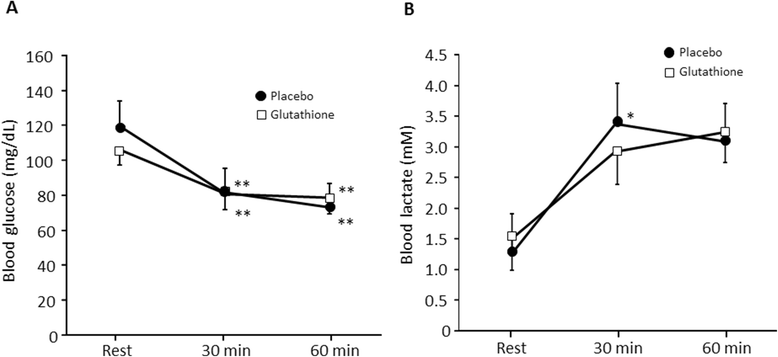
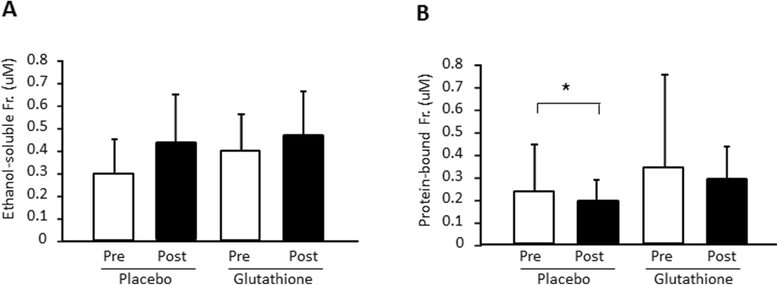
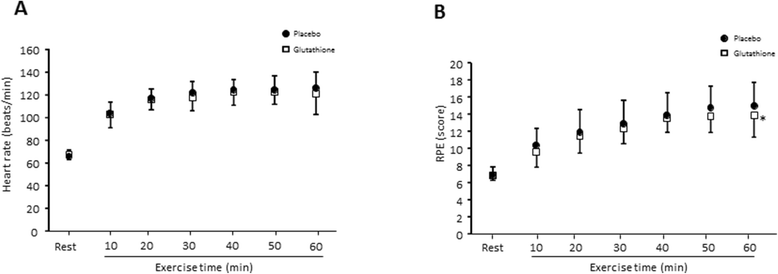
Similar articles
-
The astaxanthin-induced improvement in lipid metabolism during exercise is mediated by a PGC-1α increase in skeletal muscle.J Clin Biochem Nutr. 2014 Mar;54(2):86-9. doi: 10.3164/jcbn.13-110. Epub 2014 Feb 19. J Clin Biochem Nutr. 2014. PMID: 24688216 Free PMC article.
-
Altering the redox state of skeletal muscle by glutathione depletion increases the exercise-activation of PGC-1α.Physiol Rep. 2014 Dec 23;2(12):e12224. doi: 10.14814/phy2.12224. Print 2014 Dec 1. Physiol Rep. 2014. PMID: 25538148 Free PMC article.
-
Antioxidant supplementation reduces skeletal muscle mitochondrial biogenesis.Med Sci Sports Exerc. 2011 Jun;43(6):1017-24. doi: 10.1249/MSS.0b013e318203afa3. Med Sci Sports Exerc. 2011. PMID: 21085043
-
Oral quercetin supplementation hampers skeletal muscle adaptations in response to exercise training.Scand J Med Sci Sports. 2014 Dec;24(6):920-7. doi: 10.1111/sms.12136. Epub 2013 Oct 14. Scand J Med Sci Sports. 2014. PMID: 24118142
-
The effect of Katsura-uri (Japanese pickling melon, Cucumis melo var. conomon) and its derived ingredient methylthioacetic acid on energy metabolism during aerobic exercise.Springerplus. 2015 Jul 26;4(1):377. doi: 10.1186/s40064-015-1144-y. eCollection 2015. Springerplus. 2015. PMID: 26217554 Free PMC article.
Cited by
-
Alleviation of Cognitive and Physical Fatigue with Enzymatic Porcine Placenta Hydrolysate Intake through Reducing Oxidative Stress and Inflammation in Intensely Exercised Rats.Biology (Basel). 2022 Nov 29;11(12):1739. doi: 10.3390/biology11121739. Biology (Basel). 2022. PMID: 36552249 Free PMC article.
-
The Effect of Bioactive Aliment Compounds and Micronutrients on Non-Alcoholic Fatty Liver Disease.Antioxidants (Basel). 2023 Apr 10;12(4):903. doi: 10.3390/antiox12040903. Antioxidants (Basel). 2023. PMID: 37107278 Free PMC article. Review.
-
The Association of Circulating Amino Acids and Dietary Inflammatory Potential with Muscle Health in Chinese Community-Dwelling Older People.Nutrients. 2022 Jun 15;14(12):2471. doi: 10.3390/nu14122471. Nutrients. 2022. PMID: 35745201 Free PMC article.
-
The Effect of Glutamine Supplementation on Oxidative Stress and Matrix Metalloproteinase 2 and 9 After Exhaustive Exercise.Drug Des Devel Ther. 2019 Dec 11;13:4215-4223. doi: 10.2147/DDDT.S218606. eCollection 2019. Drug Des Devel Ther. 2019. PMID: 31849453 Free PMC article.
-
Effect of dietary antioxidant-rich foods combined with aerobic training on energy metabolism in healthy young men.J Clin Biochem Nutr. 2019 Jan;64(1):79-85. doi: 10.3164/jcbn.18-40. Epub 2018 Aug 8. J Clin Biochem Nutr. 2019. PMID: 30705516 Free PMC article.
References
LinkOut - more resources
Full Text Sources
Other Literature Sources
Miscellaneous
